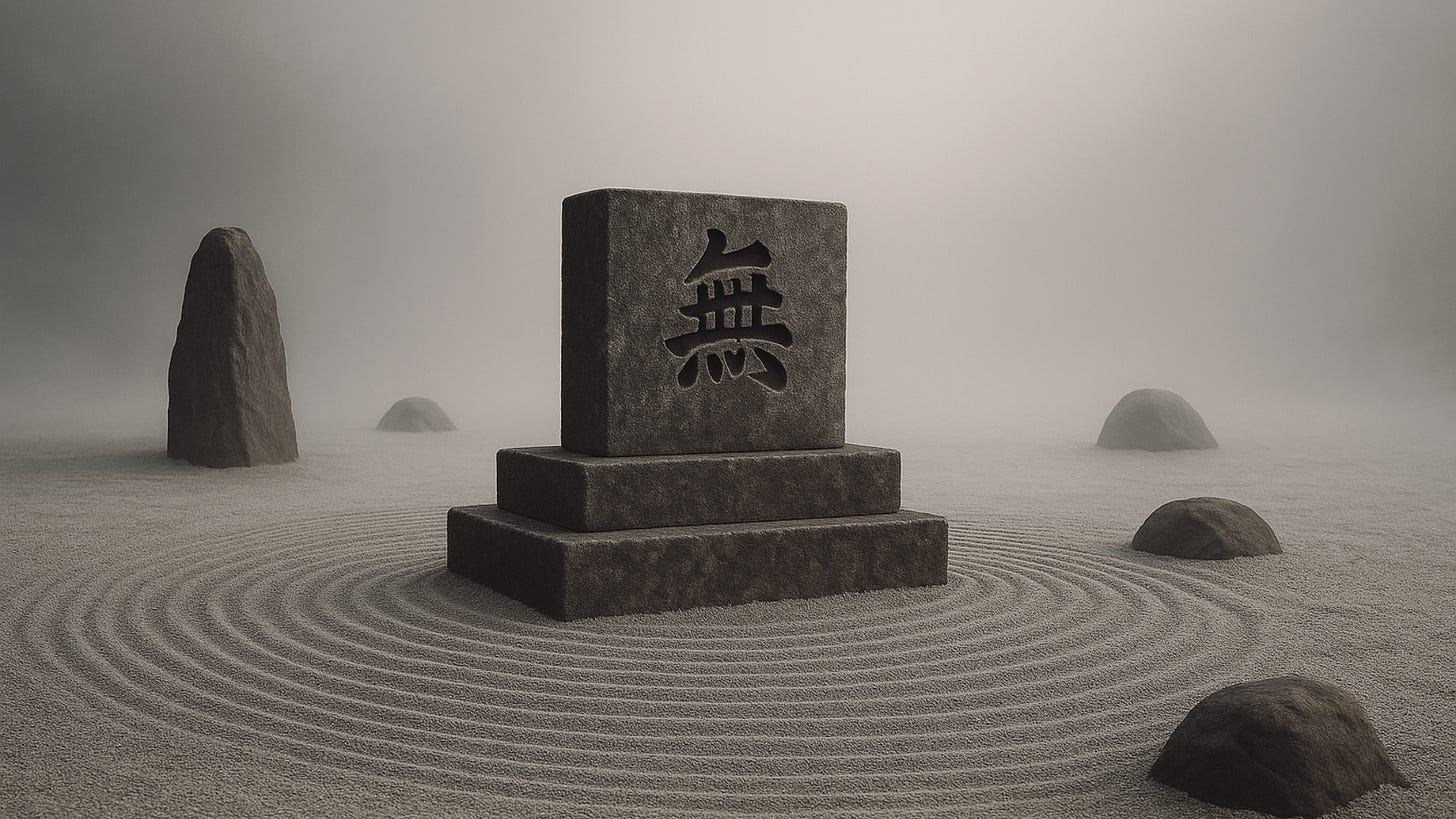Ozu Yasujiro's Cinema and Zen Philosophy in the Art of Silence
Elevating Japanese Thought into Visual Philosophy of "Mu", "Ma" and "Yohaku"
I cannot even count how many times I have watched the films of Yasujiro Ozu (1903–1963), the filmmaker I revere most deeply. Each viewing offers profound philosophical insights, brilliantly captured through his unique cinematic expression. Thus, this article delves into Ozu’s cinematic art, which skillfully integrates and elevates Zen philosophy through the ideas of Japanese philosophers like Kitaro Nishida and D.T. Suzuki.
Ozu’s renowned masterpiece “Tokyo Story” (東京物語, 1953) epitomizes the aesthetics of silence and emptiness. Through his distinct “Ozu-style” featuring a fixed low-angle camera and quiet dialogues, he consistently portrayed shifting family dynamics in Japan from prewar to postwar periods. Ozu’s films downplay overt emotional expression and dialogue, employing silence and “Ma” (間)—a distinctly Japanese notion of meaningful pauses—to weave deep resonance and profound meanings. Such silences and spaces (yohaku) in Ozu’s direction are not mere absences but actively function as presences, eliciting powerful emotional responses from his characters. For example, in “Tokyo Story,” a symbolic scene features an elderly couple and Noriko (played by Setsuko Hara) quietly observing Tokyo’s skyline, yet the camera deliberately avoids showing the scenery itself. Instead, it captures their calm, reflective expressions, compelling viewers to imagine the unseen view and share deep emotional empathy. Ozu’s portrayal of silence thus draws audiences into external narrative yohaku, enriching the cinematic experience itself.
To better comprehend Ozu’s aesthetics of silence, we must first consider Japan’s foremost philosopher, Kitaro Nishida (1870–1945). In his seminal work, “An Inquiry into the Good” (善の研究), Nishida introduced the concept of “pure experience” (純粋経験), defining it as a direct experiential state preceding the division of subject and object. Pure experience is raw perception, unmediated by conceptualization or logical judgment, inherently impossible to articulate clearly. Nishida suggests that when we perceive colors or sounds, there exists an instantaneous moment preceding cognitive identification—such as labeling something “red” or “loud”—where subject and object are unified. At that moment, there is neither self nor external object, only immersion into the totality of experience itself, a state described as “seeing without a seer.” This precisely embodies Japan’s philosophy of “Mu” (無, nothingness).
Furthermore, another foundational pillar of Nishida’s thought—also foundational to my own philosophy—is the “logic of place” (場所の論理), particularly the concept of “absolute nothingness / absolute Mu” (絶対無). Nishida viewed the ultimate reality underlying the universe as absolute nothingness, the creative topos or field within which all realities manifest. This “place of nothingness / place of Mu” is not negative emptiness, but rather a creative void (空, Ku) encompassing and giving birth to all existence. In other words, seemingly empty spaces hold infinite potential beyond specific forms or meanings.
Ozu’s cinematographic expression resonates profoundly with Nishida’s philosophy. Ozu employs fixed camera angles offering an objective perspective as if “the self is viewed from the world’s side.” This perspective immerses audiences directly into pure experience, unclouded by subjective emotions. Furthermore, Ozu’s use of silent pauses and transitional “empty shots” appear devoid of explicit meaning yet are profoundly evocative, representing precisely Nishida’s “place of nothingness.” Rather than imposing subjective interpretations, Ozu provides viewers with ample interpretive spaces / yohaku (cinematic gaps), prompting intuitive experience. Indeed, in Ozu’s films, transient human emotions like sorrow or joy are enveloped within enduring forms and spaces (“Ma”, “Yohaku”). Buddhism calls this impermanence “shogyo mujo” (諸行無常). Ozu’s carefully composed quiet frames and pauses highlight these forms as enduringly meaningful, surpassing fleeting emotional states. Through this approach, viewers are guided beyond narrative surfaces into an intuitive philosophical experience, sensing life’s transient essence.
Additionally, the Zen philosophy of D.T. Suzuki (1870–1966) provides another key perspective. Interestingly, Suzuki and Nishida were contemporaries and friends from their student years. Suzuki defines Zen enlightenment (“Satori,” 悟り) as an intuitive insight into reality’s essence, contrasting sharply with analytical, logical understanding. He describes enlightenment as direct knowledge transcending logic, dramatically reshaping one’s worldview—“opening a new perspective.” Ozu’s cinematic style aligns perfectly with Suzuki’s intuitive approach. Ozu rigorously rejects explanatory elements, subtly presenting life’s subtleties within quiet frames. Consequently, viewers, rather than passively receiving explicit information, intuitively discover meaning within minimalistic suggestion. Watching Ozu thus becomes less an analytical exercise and more an intuitive Zen experience, interpreting subtle cinematic spaces through an intrinsically Eastern intellectual process.
In Zen aesthetics, “Mu” and silence represent fullness rather than deficiency. Suzuki notes, “Emptiness (空, Ku), often misunderstood as mere void, is actually a container of infinite possibilities.” Zen arts assign meaning precisely to spaces (silences or gaps) between forms. Ozu’s films embody this Zen aesthetic vividly. His static landscapes and minimalist framing, set against “Mu,” evoke rich emotional landscapes. Scenes of characters silently gazing out windows or into empty space dissolve artificial boundaries between subject and object, directly revealing the illusory nature of such distinctions. Ozu thus visually conveys Suzuki’s “absolute nothingness,” enabling viewers to grasp intuitively the meaningful spaces between all existence—another Zen interpretation of “Mu.”
Ozu’s unique aesthetic quest for silence and emptiness profoundly reflects his life philosophy. Symbolizing this, his gravestone in a Kamakura temple bears only the single character “Mu.”
Beyond “Tokyo Story,” Ozu’s films create intersections of philosophy and cinematic art through silence and emptiness, visually expressing complex Japanese thought for the first time. Nishida’s pure experience and logic of absolute nothingness, combined with Suzuki’s Zen intuition and emptiness, deeply resonate in Ozu’s carefully crafted silences. Quiet yet profoundly resonant, Ozu’s cinematic worlds offer experiences beyond language, eloquently demonstrating the aesthetics of silence inherent in Japanese culture. Through enduring cinematic spaces, viewers learn life’s impermanence contains profound beauty, making Ozu’s films timeless, endlessly nurturing spiritual richness regardless of repeated viewings.
Indeed, Ozu’s “Mu” encapsulates his artistic vision and philosophy—a quest for truth through silence. Within quiet cinematic moments thrives abundant thoughtfulness, the true beauty of Ozu’s cinema.



